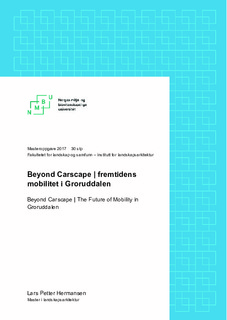| dc.contributor.advisor | Lillebye, Einar | |
| dc.contributor.author | Hermansen, Lars Petter | |
| dc.coverage.spatial | Norway, Oslo | nb_NO |
| dc.date.accessioned | 2017-09-12T13:02:19Z | |
| dc.date.available | 2017-09-12T13:02:19Z | |
| dc.date.issued | 2017 | |
| dc.identifier.uri | http://hdl.handle.net/11250/2454322 | |
| dc.description.abstract | Verden gjennomgår stor befolkningsvekst og en økt urbanisering. Videre viser prognoser at Oslo er en av byene i Europa med størst befolkningsvekst. For å imøtekomme denne vekstenmå byen fortettes i tråd med kontemporære og bærekraftige byutviklingsprinsipper. Men hva skjer med mobilitetsbehovet i alt dette?
Privatbilismen har ikke mulighet til å takle veksten i urbane områder. I tillegg til at den bidrar til forurensning, lite trivsel for fotgjengere/syklister og passivitet er plass i byen begrenset – og bilen tar opp for mye verdifullt areal per person. Vi er derfor avhengig av å finne andre løsninger påmobilitetsbehovet. Teknologien utvikles raskere enn før, og det finnes en rekke nye forskning, konsepter og ideer knyttet til nye måter å tenke mobilitet på. Kan en implementering av disse være løsningen på mobilitetsbehovet og lede til et nytt paradigmeskifte?
Gjennom å undersøke rapporter, forskningsmateriale og planer gjøres det et utvalg av fremtidens mobilitetskonsepter basert på relevans for anvendelse i Oslo, nærmere bestemt Groruddalen som fungerer som oppgavens case-område.
Etter dette vil selve Groruddalen undersøkes: ved å se på historiske trekk, morfologi, dagens trafikksituasjon og planer for fremtiden vil et utvalg behov og premisser fra hver kategori hentes ut. Disse premissene legger grunnlag for en konseptuell illustrasjon av fremtidens mobilitet i Groruddalen. Her vil nye fremtidskonsepter vises rundt utvalgte kollektivknutepunkter langs en tverrforbindelse. Konseptene er delt inn i 3 scenarier og er kategorisert etter tidsperspektiv: 2020, 2030 og 2050. De vil også sammenlignes med dagens situasjon.
På slutten er det en liten drøfting rundt Groruddalens fremtid og utvikling og hvordan tiltak faktisk kan realiseres. Selv om oppgaven tar utgangspunkt i mobilitet med mennesket i fokus tar den også stilling til arealutvikling og boligvekst i Groruddalen da dette henger sammen. Derfor er hovedproblemstillingen som følger:
Hvordan løse utfordringer knyttet til biltrafikk, arealutvikling og ventet boligvekst i Groruddalen? | nb_NO |
| dc.description.abstract | The world is facing a substantial growth in population and increased urbanisation tendencies. Furthermore, prognoses illustrate that Oslo, Norway sits among the fastest growing cities in all of Europe. To meet such growth and urbanisation demands, the city must densify in accordance with contemporary and sustainable development strategies. However, what happens with the need for mobility?
Private car transportation cannot meet these demands in urban areas. Not only does the automobile contribute to pollution, worse conditions for pedestrians and bicyclists and lead to passive and unhealthy lifestyles, car ownership confiscates too much space per person, space that is valuable and limited in the city fabric. We are therefore dependent on other solutions to comply with the demand for mobility. Technology is developing at a faster rate than before, and research, concepts and ideas for new types of mobility already exist. Could an implementation of these be the solution and lead to a paradigm change?
By going through reports, research material and plans, a selection of future mobility concepts based on their relevance for the case area Groruddalen, Oslo will be made.
Furthermore, Groruddalen itself will be examined; its history, morphology, contemporary traffic and plans for future development will lay the foundation for a conceptual illustration of future mobility in Groruddalen. Three scenarios, all sorted by time, will be presented (2020, 2030 and 2050). They will also be compared to today’s situation.
Finally, a small discussion around the future of Groruddalen and its development and how these concepts actually can be realised.
Even though the thesis primary focuses on mobility and its human element, city development and residential growth also constitutes a part, thus leading to the primary research question:
“How does one solve challenges related to car traffic, city development and expected housing growth in Groruddalen?” | nb_NO |
| dc.description.sponsorship | Statens Vegvesen | nb_NO |
| dc.language.iso | nob | nb_NO |
| dc.publisher | Norwegian University of Life Sciences, Ås | nb_NO |
| dc.rights | Attribution-NoDerivatives 4.0 Internasjonal | * |
| dc.rights.uri | http://creativecommons.org/licenses/by-nd/4.0/deed.no | * |
| dc.subject | Oslo | nb_NO |
| dc.subject | Groruddalen | nb_NO |
| dc.subject | 2050 | nb_NO |
| dc.subject | 2030 | nb_NO |
| dc.subject | 2020 | nb_NO |
| dc.title | Beyond carscape : fremtidens mobilitet i Groruddalen | nb_NO |
| dc.title.alternative | Beyond carscape : the future of mobility in Groruddalen | nb_NO |
| dc.type | Master thesis | nb_NO |
| dc.description.version | submittedVersion | nb_NO |
| dc.subject.nsi | VDP::Humanities: 000::Architecture and design: 140::Landscape architecture: 147 | nb_NO |
| dc.subject.nsi | VDP::Social science: 200::Urbanism and physical planning: 230::Urbanism: 237 | nb_NO |
| dc.source.pagenumber | 146 | nb_NO |
| dc.description.localcode | M-LA | nb_NO |

